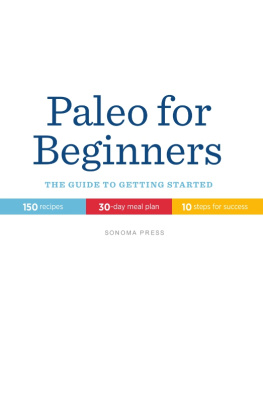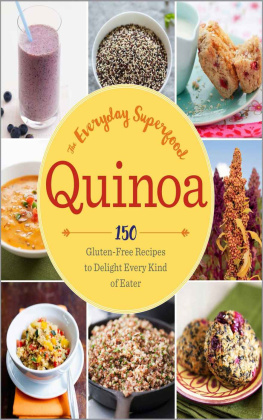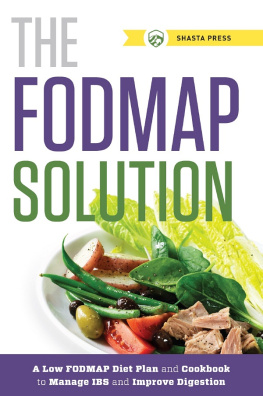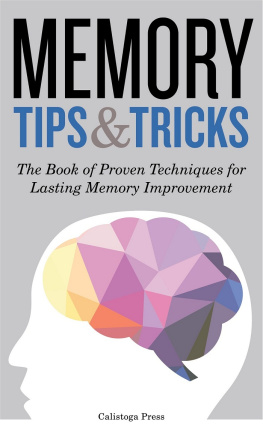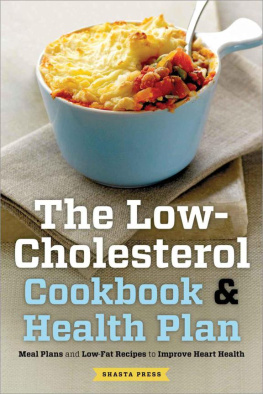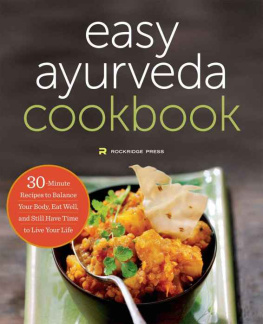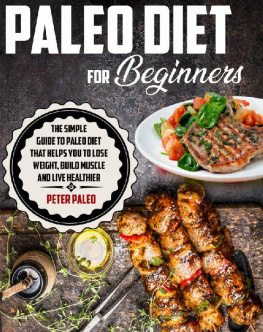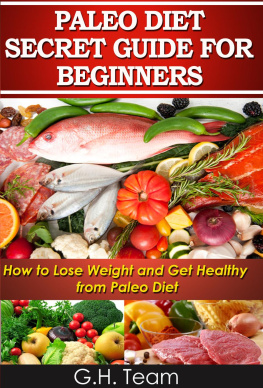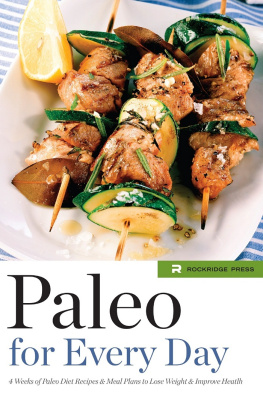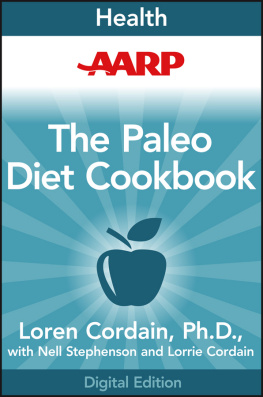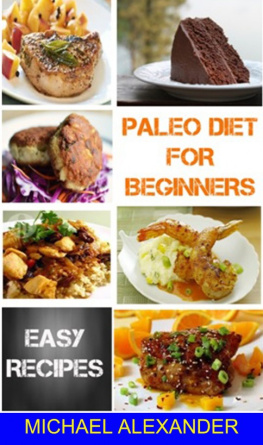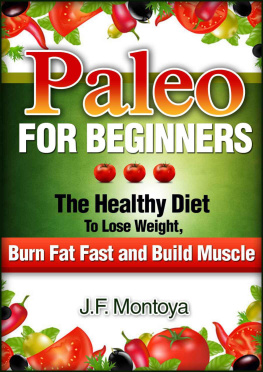Paleo for Beginners


Copyright 2013 by Sonoma Press, Berkeley, California
No part of this publication may be reproduced, stored in a retrieval system, or transmitted in any form or by any means, electronic, mechanical, photocopying, recording, scanning or otherwise, except as permitted under Sections 107 or 108 of the 1976 United States Copyright Act, without the prior written permission of the Publisher. Requests to the Publisher for permission should be addressed to the Permissions Department, Sonoma Press, 918 Parker St, Suite A-12, Berkeley, CA 94710.
Limit of Liability/Disclaimer of Warranty: The Publisher and the author make no representations or warranties with respect to the accuracy or completeness of the contents of this work and specifically disclaim all warranties, including without limitation warranties of fitness for a particular purpose. No warranty may be created or extended by sales or promotional materials. The advice and strategies contained herein may not be suitable for every situation. This work is sold with the understanding that the Publisher is not engaged in rendering medical, legal, or other professional advice or services. If professional assistance is required, the services of a competent professional person should be sought. Neither the Publisher nor the author shall be liable for damages arising herefrom. The fact that an individual, organization, or website is referred to in this work as a citation and/or potential source of further information does not mean that the author or the Publisher endorses the information the individual, organization, or website may provide or recommendations they/it may make. Further, readers should be aware that Internet websites listed in this work may have changed or disappeared between when this work was written and when it is read.
For general information on our other products and services or to obtain technical support, please contact our Customer Care Department within the U.S. at (866) 744-2665, or outside the U.S. at (510) 253-0500.
Sonoma Press publishes its books in a variety of electronic and print formats. Some content that appears in print may not be available in electronic books, and vice versa.
TRADEMARKS: Sonoma Press and the Sonoma Press logo are trademarks or registered trademarks of Arcas Publishing and/or its affiliates, in the United States and other countries, and may not be used without written permission. All other trademarks are the property of their respective owners. Sonoma Press is not associated with any product or vendor mentioned in this book.
Photo Credits: StockFood / Sarah Hogan, p.77; StockFood / George Crudo, p.82; StockFood / Alison Miksch, p.108; StockFood / Yelena Strokin, p.134; StockFood / Wolfgang Schardt, p.183; Stock-Food / Michael Cogliantry, p.186; StockFood / Jim Norton, p.195; StockFood / Bernhard Winkelmann, p.214; StockFood / Alena Hrbkova, p.237; StockFood / Klaus Arras, p.244; StockFood / LaFood-Thomas Dhellemmes, p.258; all other photographs www.shutterstock.com .
ISBN: Print 978-0-9895586-1-7
Contents

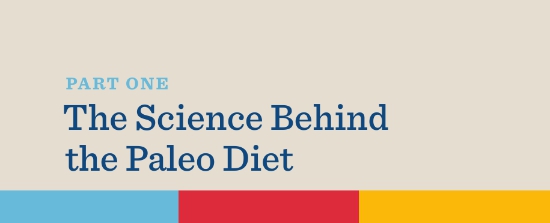

CHAPTER ONE
What Is the Paleo Diet?
T he Paleolithic diet, caveman diet, or Paleo diet is a popular diet founded on the premise that our ancestors had a healthier diet and had better health than modern humans. Before the advent of agriculture, people were hunter-gatherers who subsisted on a diet of meats, fish, nuts, fruits, and vegetables rather than the refined sugars, dairy, grains, salt, and processed foods that are today's common foods.
The theory behind the Paleo diet is that the human body has not yet adapted to grain-based nourishment, which leads to many of the diseases plaguing contemporary society. Cardiovascular disease, obesity, diabetes, stroke, and even infertility can all be linked back to these modern diet changes because human beings are genetically hardwired to eat the hunter-gatherer diet that was followed for about 99.5 percent of human history. Studies have also shown that human brain function and physical ability peaked just before the agricultural revolution.
Why did our diet shift so dramatically? The simple answer is that human beings grouped together for support and companionship, which led to settling in one area rather than roaming around in search of food. This static lifestyle was conducive to agriculture and animal husbandry. Cereal grains and legumes became a convenient source of calories, and people stopped moving their bodies to forage and hunt for survival. This combination of inactivity and diet change has created an increasingly fat society that is actually malnourished due to a lack of nutrients in its food. Following the Paleo diet can address this nutrient deficit, and can be a huge step toward feeling and looking better.
What Do You Eat on the Paleo Diet?
We do not know definitively what our Paleo forebearers ate on a daily basis, and many foods they did consume are no longer available today because of evolution and extinction. The idea of the Paleo diet is to mimic the perceived caveman diet using modern food equivalents, refraining from anything that a caveman would not have been able to find. This means eliminating all processed foods, grains, legumes, processed sugars, processed oils, and dairy because these items came about after the agricultural and industrial revolutions. Since these forbidden foods make up the bulk of the standard American diet (SAD), many people are left wondering what exactly is on the Paleo menu.
Paleo-friendly foods include meats, fish, seafood, eggs, vegetables, fruit, healthy fats, nuts, tubers, and seeds. If you choose to follow a Paleo diet, you will be eating the freshest, healthiest, most nutrient-packed foods you can find, and cooking them in ways that do not add fats and calories to the finished dishes. These choices mirror what every medical professional and nutritionist has been recommending for years to produce vibrant, good health.
CHAPTER TWO
Gluten
The Danger in Plain Sight
I t is hard to believe that the slices of warm, crusty bread waiting in the bread basket can make you sick because they contain grain. If you think about all the foods you eat during a usual day and which ones contain some sort of cereal grain, you might feel as if you are in the middle of a diet minefield. Grains contain gluten, which can be dangerous to a surprising number of people.
Gluten is a sticky protein that is found in all the grains that are so prevalent in the modern diet. It can be very hard to digest and can irritate the body. Gluten is also what gives bread and baked products their lovely texture and structure, so many people do not want to stop eating it even if they have a gluten sensitivity. Gluten sensitivity is widely misunderstood and more far-reaching than many people realize. It is an autoimmune disease that creates chronic inflammation in all the organ systems in the body. This inflammation can occur if your digestive system is constantly weakened by gluten sensitivity so that it does not eliminate undigested proteins. The undigested proteins then float through the bloodstream instead, which creates an autoimmune reaction (Cordain, 2005).

